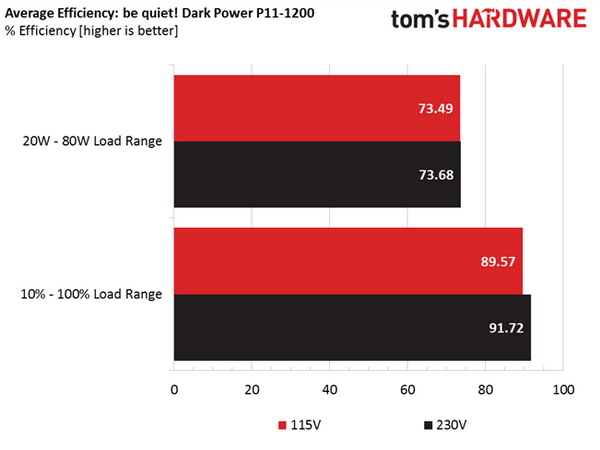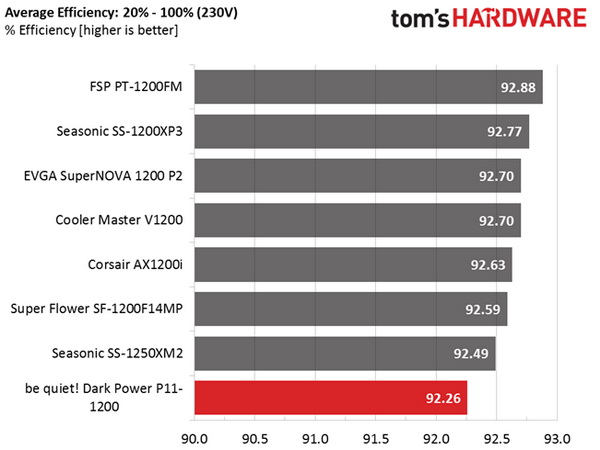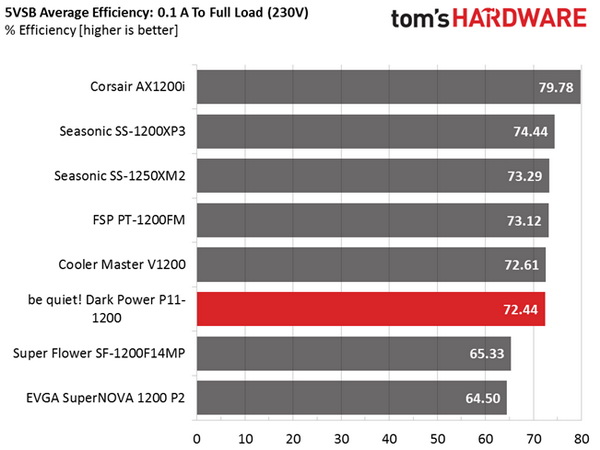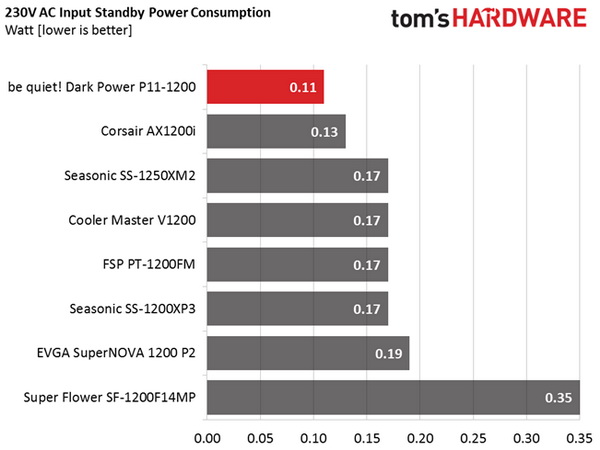Be Quiet! Dark Power Pro 11 1200W PSU Review
be quiet! says it's committed to building silent products, including the company's top PSU line, the Dark Power Pro 11. In this review, we will put the 1200 W Dark Power Pro 11 model to the test, which promises good performance and silent operation.
Why you can trust Tom's Hardware
Efficiency, Temperature And Noise
Efficiency
Our efficiency testing procedure is detailed here.
Using the results from the previous page, we plotted a chart showing be quiet! Dark Power P11-1200's efficiency at low loads, and loads from 10 to 110 percent of the PSU's maximum-rated capacity.




With normal loads, be quiet!'s unit took over last place, whereas with light loads it managed to beat only Corsair's offering, and by a very small margin. Obviously, this platform cannot compete with other high-end PSUs in this area of capacity, and be quiet! should make the suitable modifications to rectify the situation and bring their flagship PSU offering up to speed.
Efficiency At Low Loads
In the following tests, we measure the efficiency of be quiet!'s Dark Power P11-1200 at loads significantly lower than 10 percent of the device's maximum capacity (the lowest load the 80 PLUS standard measures). The loads we dialed were 20, 40, 60 and 80W. This is important for representing when a PC is idle, with power-saving features turned on.
| Test # | 12V | 5V | 3.3V | 5VSB | Power(DC/AC) | Efficiency | Fan Speed | Fan Noise | PF/AC Volts |
|---|---|---|---|---|---|---|---|---|---|
| 1 | 1.209A | 0.491A | 0.471A | 0.195A | 19.60W | 59.63% | 420 RPM | 19.0 dBA | 0.870 |
| 12.022V | 5.044V | 3.375V | 5.115V | 32.87W | 115.1V | ||||
| 2 | 2.451A | 0.990A | 0.977A | 0.389A | 39.73W | 73.09% | 450 RPM | 19.2 dBA | 0.932 |
| 12.019V | 5.041V | 3.372V | 5.105V | 54.36W | 115.1V | ||||
| 3 | 3.694A | 1.476A | 1.481A | 0.584A | 59.79W | 78.95% | 465 RPM | 20.6 dBA | 0.954 |
| 12.016V | 5.038V | 3.370V | 5.096V | 75.73W | 115.1V | ||||
| 4 | 4.926A | 1.984A | 1.958A | 0.785A | 79.75W | 82.29% | 510 RPM | 21.1 dBA | 0.966 |
| 12.014V | 5.034V | 3.367V | 5.087V | 96.91W | 115.1V |
At low loads, efficiency was adequate, but most of the competition's PSUs offer higher efficiency at this load range. On the other hand, the output noise results are great since the PSU was inaudible, despite the high ambient temperatures at which we performed these tests.
5VSB Efficiency
The ATX specification states that 5VSB standby supply efficiency should be as high as possible, recommending 50 percent or higher efficiency with 100mA of load, 60 percent or higher with 250mA of load and 70 percent or higher with 1A or more of load.
We will take four measurements: one each at 100, 250 and 1000mA, and one with the full load the 5VSB rail can handle.
Get Tom's Hardware's best news and in-depth reviews, straight to your inbox.
| Test # | 5VSB | Power (DC/AC) | Efficiency | PF/AC Volts |
|---|---|---|---|---|
| 1 | 0.101A | 0.52W | 69.33% | 0.062 |
| 5.121V | 0.75W | 115.1V | ||
| 2 | 0.251A | 1.28W | 75.29% | 0.132 |
| 5.115V | 1.70W | 107.6V | ||
| 3 | 1.002A | 5.10W | 77.98% | 0.325 |
| 5.087V | 6.54W | 115.1V | ||
| 4 | 3.002A | 15.05W | 76.13% | 0.453 |
| 5.014V | 19.77W | 115.1V |


The 5VSB rail wasn't as efficient as we wanted it to be. It didn't manage to surpass or even get close to the 80 percent mark, in any case.
Power Consumption In Idle And Standby
| Mode | 12V | 5V | 3.3V | 5VSB | Power (AC) | PF/AC Volts |
|---|---|---|---|---|---|---|
| Idle | 12.259V | 5.048V | 3.379V | 5.125V | 12.84W | 0.605 |
| 115.1V | ||||||
| Standby | 0.07W | 0.006 | ||||
| 115.1V |


In the table above, you'll find the power consumption and voltage values of all rails (except -12V) when the PSU is idle (powered on, but without any load on its rails), and the power consumption when the PSU is in standby mode (without any load, at 5VSB).
Vampire power was very low with both 115V and 230V input. With such low power consumption at standby, this unit could easily achieve good efficiency on the 5VSB rail, especially at light loads.
Fan RPM, Delta Temperature And Output Noise
Our mixed noise testing is described in detail here.
The first chart below illustrates the cooling fan's speed (RPMs), and the delta between input and output temperature. The results were obtained at 37 C (98.6 F) to 49 C (120.2 F) ambient temperature.
The next chart shows the cooling fan's speed (RPMs) and output noise. We measured acoustics from 1 meter away, inside a small, custom-made anechoic chamber with internals completely covered in sound-proofing material (be quiet! Noise Absorber kit). Background noise inside the anechoic chamber was below 18 dB(A) during testing, and the results were obtained with the PSU operating at 37 C (98.6 F) to 49 C (120.2 F) ambient temperature.


The following graph illustrates the fan's output noise over the entire operating range of the PSU. The same conditions of the above graph apply to our measurements, though the ambient temperature was between 28 C (82.4 F) and 30 C (86 F).
Up to around 650 W load and at normal ambient temperature the Dark Power unit's fan will spin at very low speeds, which results in an inaudible operation. Afterward, it increases its speed in order to offer sufficient airflow and push the hot air out of the unit's internals, and up to the 800 W - 850 W region it manages to keep its noise at very low noise levels. With 1 kW load and above, the PSU's noise is definitely noticeable. Compared with most 1.2 kW units on the market today, however, be quiet!'s offering makes significantly less noise.
Current page: Efficiency, Temperature And Noise
Prev Page Load Regulation, Hold-Up Time And Inrush Current Next Page Cross-Load Tests And Infrared Images
Aris Mpitziopoulos is a contributing editor at Tom's Hardware, covering PSUs.
